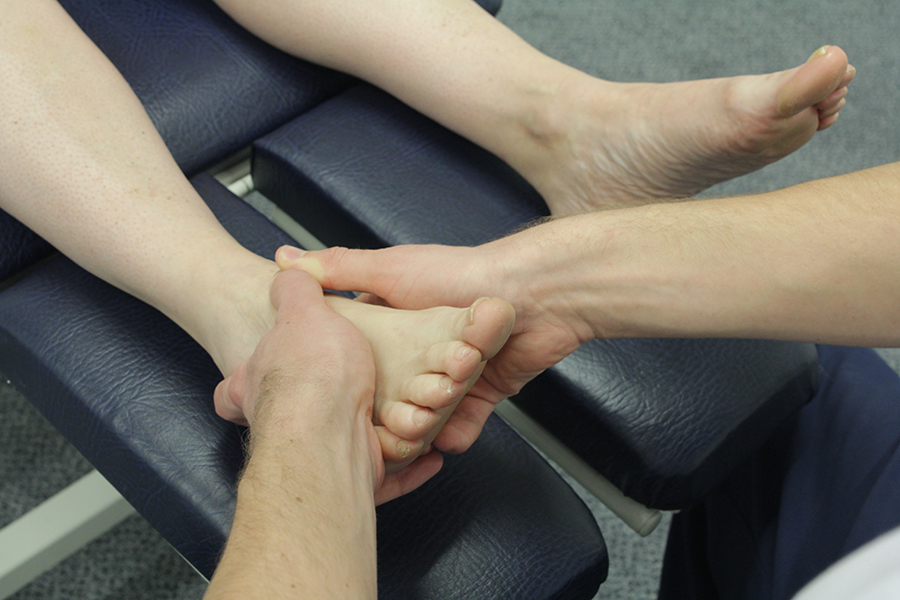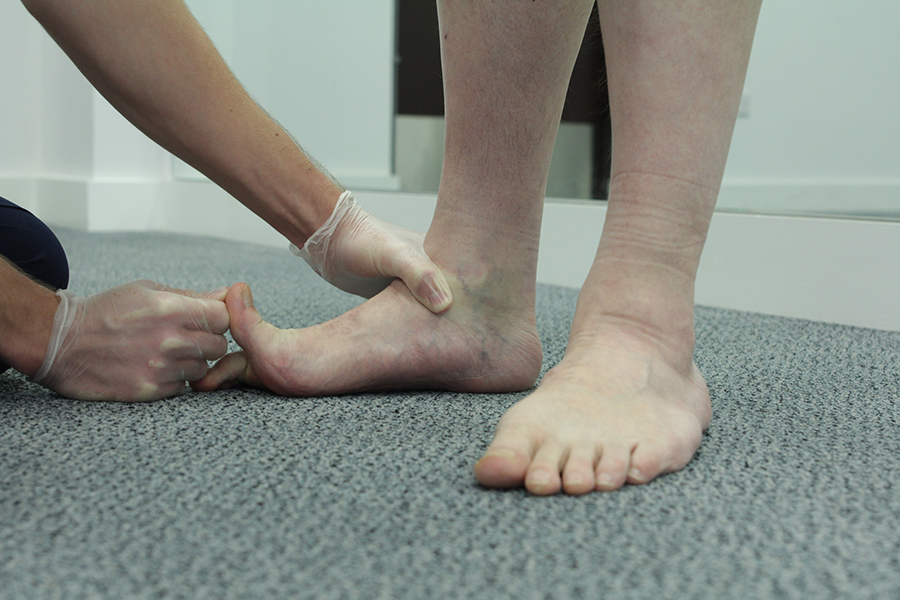Ankle instability
Ankle instability refers to the frequent 'going over' on the foot, or the ankle giving way.
If you have ankle instability Chiropody.co.uk can help you with the prescription of orthoses, which are designed to control ankle movement. Orthoses are prescribed alongside proprioceptive and strengthening exercises, designed to improve the function of the ankle and prevent you from 'going over'.
Ankle instability describes a condition whereby the ligaments (these connect bones to other bones) on either the inside or outside of the ankle are loose or have been stretched. When the ankle ligaments have been stretched the ankle becomes unstable, and the person who has ankle instability will feel unsteady on their feet and will often 'go over' on their ankle.
Ankle instability is common after a sprain, particularly if a sprain has occurred more than once.

Ankle instability occurs when the ligaments that support the ankle are stretched. The ligaments on the inside and outside of the ankle are responsible for stabilising the ankle joint, preventing the ankle from rolling over. Ligaments are responsible for stabilizing the joint, therefore, if the ligaments are loose the joint will become unstable.
If a person has suffered an ankle sprain (this is when a person goes over on their foot) the ligaments can tear and stretch. If these ligaments do not heal correctly the person may be left with ankle instability.
A person may also have ankle instability if they have a condition that causes their ligaments to be loose, for example, ligamentous laxity.
The most common signs of ankle instability include the following:
Ankle instability is diagnosed based on the history, your account of the problem, and an examination of the ankle. During the examination the stability of the ankle is assessed. The ankle presenting with ankle instability will be compared to the other ankle.

If you have ankle instability in one or both of your ankles then podiatry can help you. There are a number of benefits to podiatric treatment for ankle instability, the first being stabilisation of the foot and ankle, which may be achieved with the use of:
Podiatry can benefit anyone suffering from ankle instability with the prescription of exercises. Proprioception is the sense that tells you where you are in space. The benefit of proprioceptive exercises for ankle instability is re-education of the ligaments in the ankle, which allows the body to sense the ankles position and then react with the correct movement. Strengthening of the muscles that surround the ankle joint, particularly those that point the foot outwards will also benefit anyone with ankle instability, as these are the muscles that resist inversion of the ankle.
Podiatry for ankle instability would involve the following:
Ankle instability describes an ankle that is unstable, this means that the person will often go over on their ankle and will feel unsteady on their feet.
Ankle instability affects the ligaments on either the outside or inside of the ankle, these ligaments help to stabilise the ankle and prevent it from going over. When the ligaments of the ankle are loose due to a pre-existing condition such as ligamentous laxity, or have been stretched due to an ankle sprain the ankle can become unstable.
If you feel that you have ankle instability visit us at Chiropody.co.uk. At Chiropody.co.uk we will thoroughly assess, diagnose and formulate a treatment plan specific to you. Treatment for ankle instability will aim to support and stabilize the ankle, so that you feel steady on your feet and can get on with life and your everyday activities without the fear of 'going over 'on your ankle.
To arrange an assessment with us at Chiropody.co.uk please email office@chiropody.co.uk or call 0330 088 4222.
If you have ankle instability Chiropody.co.uk can help you with the prescription of orthoses, which are designed to control ankle movement. Orthoses are prescribed alongside proprioceptive and strengthening exercises, designed to improve the function of the ankle and prevent you from 'going over'.
What is ankle instability?
Ankle instability describes a condition whereby the ligaments (these connect bones to other bones) on either the inside or outside of the ankle are loose or have been stretched. When the ankle ligaments have been stretched the ankle becomes unstable, and the person who has ankle instability will feel unsteady on their feet and will often 'go over' on their ankle.
Ankle instability is common after a sprain, particularly if a sprain has occurred more than once.

What causes ankle instability?
Ankle instability occurs when the ligaments that support the ankle are stretched. The ligaments on the inside and outside of the ankle are responsible for stabilising the ankle joint, preventing the ankle from rolling over. Ligaments are responsible for stabilizing the joint, therefore, if the ligaments are loose the joint will become unstable.
If a person has suffered an ankle sprain (this is when a person goes over on their foot) the ligaments can tear and stretch. If these ligaments do not heal correctly the person may be left with ankle instability.
A person may also have ankle instability if they have a condition that causes their ligaments to be loose, for example, ligamentous laxity.
What are the signs and symptoms of ankle instability?
The most common signs of ankle instability include the following:
- Feeling unsteady
- Feet and ankles giving way
- Frequent going over on the ankle
- Frequent ankle sprains
- Pain/tenderness
- Swelling
How is ankle instability diagnosed?
Ankle instability is diagnosed based on the history, your account of the problem, and an examination of the ankle. During the examination the stability of the ankle is assessed. The ankle presenting with ankle instability will be compared to the other ankle.

Benefits of podiatry for ankle instability
If you have ankle instability in one or both of your ankles then podiatry can help you. There are a number of benefits to podiatric treatment for ankle instability, the first being stabilisation of the foot and ankle, which may be achieved with the use of:
- Orthoses
- Stretching Programmes
- Proprioceptive Exercise
- Balance exercises
- Strengthening Exercises
- Ankle supports
- Taping/strapping
- Acupressure
- Manipulation / mobilisation
- Massage
- Myofascial release
- Soft tissue mobilisation
- Trigger point therapy
- Advice and education
- Footwear review
Podiatry can benefit anyone suffering from ankle instability with the prescription of exercises. Proprioception is the sense that tells you where you are in space. The benefit of proprioceptive exercises for ankle instability is re-education of the ligaments in the ankle, which allows the body to sense the ankles position and then react with the correct movement. Strengthening of the muscles that surround the ankle joint, particularly those that point the foot outwards will also benefit anyone with ankle instability, as these are the muscles that resist inversion of the ankle.
What would podiatry for ankle instability involve?
Podiatry for ankle instability would involve the following:
- A history
- An examination of both ankles
- A Biomechanical assessments and gait analysis
- An explanation of the findings and what can be done
- Appropriate treatment
Summary
Ankle instability describes an ankle that is unstable, this means that the person will often go over on their ankle and will feel unsteady on their feet.
Ankle instability affects the ligaments on either the outside or inside of the ankle, these ligaments help to stabilise the ankle and prevent it from going over. When the ligaments of the ankle are loose due to a pre-existing condition such as ligamentous laxity, or have been stretched due to an ankle sprain the ankle can become unstable.
If you feel that you have ankle instability visit us at Chiropody.co.uk. At Chiropody.co.uk we will thoroughly assess, diagnose and formulate a treatment plan specific to you. Treatment for ankle instability will aim to support and stabilize the ankle, so that you feel steady on your feet and can get on with life and your everyday activities without the fear of 'going over 'on your ankle.
To arrange an assessment with us at Chiropody.co.uk please email office@chiropody.co.uk or call 0330 088 4222.
Save 5% by booking an appointment online.

Find your nearest clinic
We have clinics located throughout the North West. We also provide a home visit service.
Find out more »

No waiting lists!
Tired of waiting for treatment? Be seen by a podiatrist today!
Find out more »

Not sure how we can help?
Speak to a podiatrist to find out how we can help. Call us on 0330 088 4222.
Find out more »
We work with:

Individuals

Organisations

Health professionals
Get in Touch!
0330 088 4222
If you would like to speak to one of our specialists then please complete this form.
We are open 7 days a week








